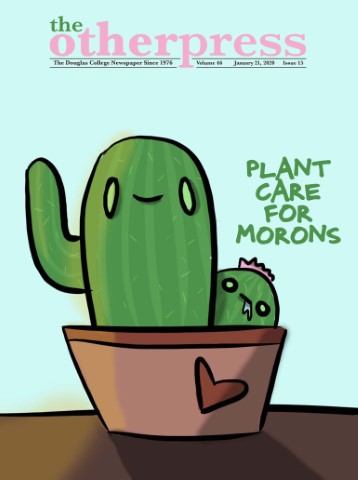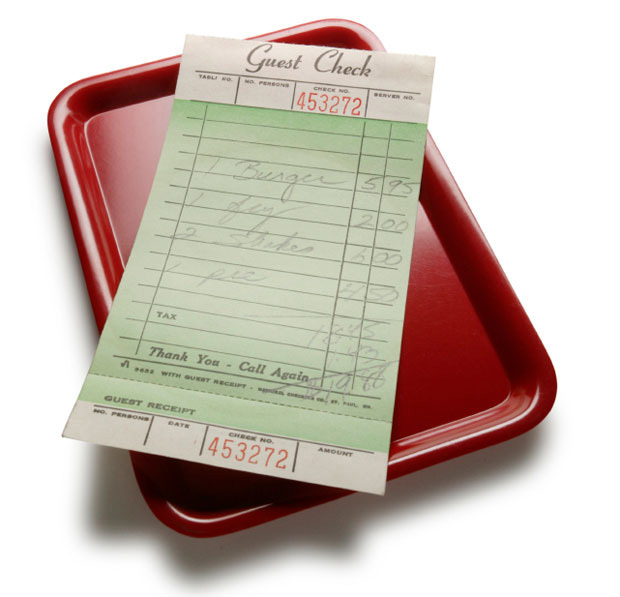
Cover layout by Lauren Kelly
From moron to moron, let’s talk about adding greenery to your indoor space
By Jacey Gibb, Distribution Manager
If a person impulsively buys a plant from IKEA, and it dies less than a week later because you don’t know the first thing about owning a houseplant, did it even exist?
Life is full of philosophical questions.
There are a number of cheeky articles about the topic. The Economist published an article in 2018 titled, “Instead of houses, young people have houseplants.” Fun wordplay aside: ouch. The year before that article, the Washington Post published one titled, “Millennials are filling their home—and the void in their hearts—with houseplants”
Now, I can’t guarantee that houseplants will fill “the void” in your heart or satiate those of you thirsty for houses. In fact, some of the touted benefits from houseplants, such as they help purify the air in your living space, have been recently disproven. (A Drexel University study released last year found the ultimate air purifier is having a few open windows, which you’d need almost 700 plants to reap the same benefit.) However, houseplants provide a few tangible benefits. They look great. They add a fresh tinge to otherwise drab rooms. You reap self-satisfaction at not only keeping something alive, but watching it grow under your supervision. I can’t point to any official studies to back me up here, so you’ll have to rely on my personal testimonials. Houseplants are fucking great.
And while indoor plants are a fantastic hobby to adopt, they also come with a thousand idiosyncrasies. The more you learn about plants, the less you’ll realize you know, but here are a few areas worth covering before you invest in indoor greenery.
Ah, ha, ha, ha, stayin’ alive, stayin’ alive
I’m a man of
efficiency in life, so most of these upkeep tips reflect that. I probably don’t
take enough care of my plants, but my name ain’t Poison Ivy, so deal with it.
Here are a few tips to keep those stemmed babies alive:
Mist your plants
every few days. I joined the misting club a year ago and have
noticed a considerable improvement in almost all of my plants. Since most
houseplants are considered tropical, the idea here is recreating the humidity
of those warmer climates. A few good sprays in the morning will coat the
leaves, while doing it earlier also gives them a chance to dry off.
Remove browning or
dead foliage. Plants
naturally go through cycles, and sometimes an otherwise healthy plant will
spawn yellowing or brown foliage. There are a few reasons why you should remove
these bits. Most importantly, there’s a chance that something is attacking the
plant, and you want to remove any chances of spreading the cause. The plant is
also still providing nutrients to that area, even when it’s on death’s door, so
physically removing this will prevent wasting energy.
Feed your plants. I’m not talking about
feeding your houseplants table scraps, but rather a liquid plant fertilizer.
Houseplants have a limited environment since they’re pot-bound, and you need to
reintroduce nutrients to the soil. Liquid fertilizers are cheap and easy to
use: Just mix them in some water, and then add to your plants. Some folks
online argue that this should be done weekly or bi-weekly, but you can probably
get away with once a month.
Check the roots. A relatively new concept to me, roots can actually be a solid indicator for a plant’s overall health. If roots are growing, then the plant is doing well. Given a larger environment, this would mean the plant is flourishing and healthy but if the plant is confined to a pot, rampant roots can end up overwhelming the plant. Root-pruning refers to trimming a plant’s roots and repotting it. This also gives your plant a chance to get bigger.
Buy plants for the space that you have, not the space that you want
I get it. Vancouver loves its dingey, semi-illegal basement suites. You know who doesn’t love them? Most plants.
You see, plants need natural light to perform photosynthesis, which is essentially how they make their food. Some plants can scamp by on small amounts of light or even prefer darker areas, but the majority require at least a few hours of indirect light.
If your home has south-facing windows, then this is perfect. South-facing windows provide the most opportunity for sunlight and the majority of plants will thrive here. East-facing and west-facing windows are attractive second options, as either provides at least a few solid hours of direct sunlight, assuming the windows aren’t blocked on the exterior.
The real struggle comes with north-facing dwelling, which happens to be the direction my own windows face. Just because your apartment faces north doesn’t mean you have to resign yourself to the fake plant lifestyle. However, you’ll have to be a lot more strategic and attentive than your lucky south-facing counterparts. If your windows have blinds or curtains, make a habit of opening them daily, so enough light comes in.
It’s also better to place plants closer to windows, as opposed to the opposite side of the room. These few metres of variance can make a big difference.
If you’re not sure whether a spot gets enough light, set the plant up and keep an eye on it. If the leaves begin yellowing or start to fall off, this might be a sign you need to relocate it somewhere brighter. A lot of indoor plant ownership comes down to trial and error, so keep experimenting and don’t get discouraged.
Consider your furry roommates
If you have pets, you really need to research before purchasing any plants. A surprising amount of common houseplants are toxic to cats and dogs, and range from a mild irritant to deadly. The American Society for the Prevention of Cruelty to Animals (ASPCA) has a lengthy database online on which plants are safe for animals, so always check before bringing a new plant into your home.
It’s also worth mentioning to doublecheck any second-hand tips you’ve received. For example, I’d always heard that poinsettias are highly poisonous for cats, but in fact, they’re only a slight irritant when ingested. We’re living in 2020, so there’s no reason you can’t verify information with a quick Internet search of your own
Cats, in particular, can be little shits when it comes to nibbling on plants. Unlike dogs, which can be trained to not eat plants, cats lack that cognitive capacity. Dogs can learn to avoid something that makes them sick, while cats will just keep coming back to it. If you’re truly in love with a plant that’s harmful to pets, keep them on a high shelf or atop a bookcase, so you don’t endanger your dumb, loveable cat.
Don’t let this article fool you into thinking I’ve got it all figured out when it comes to being a plant dad. I’ve killed enough plants to be locked up for serial plant murder, but I’ve also learned enough from those mistakes, and have a nice mini-urban jungle in my apartment.
Sometimes you forget to water for several weeks, and the plant does just fine. Other times, you do everything right, and the plant dies anyways. Maybe there was a fungus in the soil, or perhaps an unfortunate bug infestation lays siege. Some of these things can be avoidable with more experience and knowledge, while others are just plain bad luck. My advice: Just keep trying until you find the plants that are right for you. Or maybe invest in some fake plants, which will technically live on for centuries.
SIDEBAR: Indoor plant supply checklist
Like most hobbies, owning indoor plants comes with a few upfront costs. The good news is everything on this list costs less than most plants and will last for several generations of leafed children.
Spray water bottle: for regularly misting your plants
Liquid fertilizer: for replenishing the nutrients lost overtime in potted plants
Larger pots: assuming your plant continues to grow, you’ll eventually need to repot it
Potting soil: invest in a bag of specialized soil for your indoor plants (avoid using regular dirt from outside)
Patience: seriously


